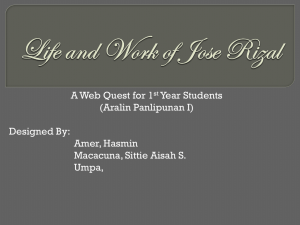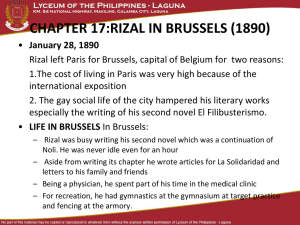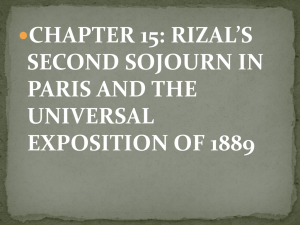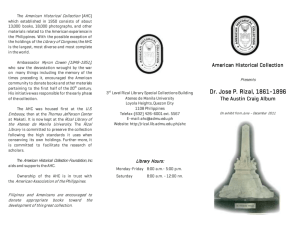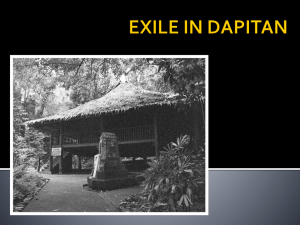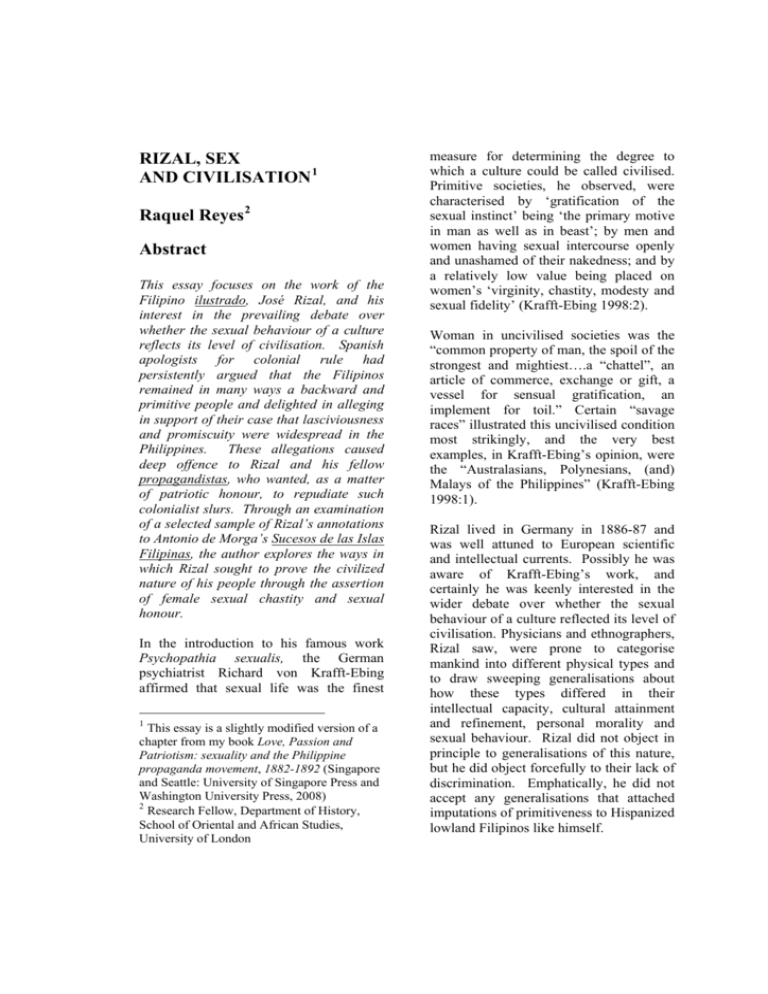
RIZAL, SEX
AND CIVILISATION 1
Raquel Reyes 2
Abstract
This essay focuses on the work of the
Filipino ilustrado, José Rizal, and his
interest in the prevailing debate over
whether the sexual behaviour of a culture
reflects its level of civilisation. Spanish
apologists for colonial rule had
persistently argued that the Filipinos
remained in many ways a backward and
primitive people and delighted in alleging
in support of their case that lasciviousness
and promiscuity were widespread in the
Philippines. These allegations caused
deep offence to Rizal and his fellow
propagandistas, who wanted, as a matter
of patriotic honour, to repudiate such
colonialist slurs. Through an examination
of a selected sample of Rizal’s annotations
to Antonio de Morga’s Sucesos de las Islas
Filipinas, the author explores the ways in
which Rizal sought to prove the civilized
nature of his people through the assertion
of female sexual chastity and sexual
honour.
In the introduction to his famous work
Psychopathia sexualis, the German
psychiatrist Richard von Krafft-Ebing
affirmed that sexual life was the finest
1
This essay is a slightly modified version of a
chapter from my book Love, Passion and
Patriotism: sexuality and the Philippine
propaganda movement, 1882-1892 (Singapore
and Seattle: University of Singapore Press and
Washington University Press, 2008)
2
Research Fellow, Department of History,
School of Oriental and African Studies,
University of London
measure for determining the degree to
which a culture could be called civilised.
Primitive societies, he observed, were
characterised by ‘gratification of the
sexual instinct’ being ‘the primary motive
in man as well as in beast’; by men and
women having sexual intercourse openly
and unashamed of their nakedness; and by
a relatively low value being placed on
women’s ‘virginity, chastity, modesty and
sexual fidelity’ (Krafft-Ebing 1998:2).
Woman in uncivilised societies was the
“common property of man, the spoil of the
strongest and mightiest….a “chattel”, an
article of commerce, exchange or gift, a
vessel for sensual gratification, an
implement for toil.” Certain “savage
races” illustrated this uncivilised condition
most strikingly, and the very best
examples, in Krafft-Ebing’s opinion, were
the “Australasians, Polynesians, (and)
Malays of the Philippines” (Krafft-Ebing
1998:1).
Rizal lived in Germany in 1886-87 and
was well attuned to European scientific
and intellectual currents. Possibly he was
aware of Krafft-Ebing’s work, and
certainly he was keenly interested in the
wider debate over whether the sexual
behaviour of a culture reflected its level of
civilisation. Physicians and ethnographers,
Rizal saw, were prone to categorise
mankind into different physical types and
to draw sweeping generalisations about
how these types differed in their
intellectual capacity, cultural attainment
and refinement, personal morality and
sexual behaviour. Rizal did not object in
principle to generalisations of this nature,
but he did object forcefully to their lack of
discrimination. Emphatically, he did not
accept any generalisations that attached
imputations of primitiveness to Hispanized
lowland Filipinos like himself.
Rizal, Sex and Civilisation
Krafft-Ebing’s reference to the Philippines
gave added currency to the notion that
Filipinos could be classified as primitive
on the basis of their reputedly unbridled
sexual life. To understand his assertion it
is instructive to trace its intellectual
genealogy. Ultimately, we shall see, it
rested on Spanish sources that the
propagandistas saw as tainted by racial
prejudice and imperial self-interest.
Krafft-Ebing’s footnote reveals his
indebtedness to Heinrich Ploss, whose
ambitiously titled magnum opus Das Weib
in der Natur – und Volkerkunde first
appeared in 1884. 3 Ploss in turn relied
primarily on the works of three authors, all
of whom Rizal later met: the Austrian
Ferdinand Blumentritt ([1880] 1980) 4 ; as
well as the Germans Alex Schadenberg
(1880:133) (who had studied the Negritos)
and Fedor Jagor (1873 and 1880) (who
had travelled widely in the archipelago).
Ploss repeated Blumentritt’s observations
that
the
Tagalogs
of
Luzon,
notwithstanding their “higher civilisation
and milder morals” in relation to the
Negritos
and
“mountain
tribes,”
manifested a pronounced lack of sexual
modesty. Blumentritt had even gone so
far as to say that the Tagalogs displayed a
number of animal-like faculties. They
were remarkably adept at manipulating
their toes to pick up small objects, and
they retained an acute sense of smell,
especially the women, who were “able to
find out whether the men nearby them are
sexually excited or not” (Blumentritt
1980:34-35).’ The excessive immorality
and sensuality of the Tagalogs,
Blumentritt affirmed, were part of the
‘pagan legacy’ that endured despite the
evangelizing efforts of the Spanish friars.
In making these assertions, Blumentritt
drew upon, and thereby gave added
credence to, the travel observations of
Francisco Cañamaque, a Spanish journalist
and traveller whom the propagandistas
would
later
energetically
attack
(Cañamaque 1877 and 1879). Immorality,
Blumentritt gleaned from Cañamaque, was
widespread both in Manila and in the
countryside of the Tagalog region:
Blumentritt in particular was a key source,
especially his Versuch einer Ethnographie
der Philippinen, which was published in
1882 – four years before the Austrian
orientalist became acquainted with Rizal
and the Filipino propaganda campaign.
3
Undergoing numerous re-publications, the
work was continued and revised after the
author’s death by his collaborators Max
Bartels and Paul Bartels. In its final
incarnation, published in 1935, Ploss’s work
expanded into three volumes which with the
aid of numerous intimate illustrations ‘dealt
fully’, its editor boasted, ‘with those aspects of
a woman’s life which are little known even to
gynaecologists.’ (Bartels and Bartels, eds.
1935)
4
Besides relying extensively on Blumentritt’s
Versuch einer Ethnographie, Ploss also
consulted the same author’s ’Der Ahnenkultus
in. die religiosen Anschauungen der Malayen
des Philippinen-Archipel’, Mittheilungen.
d.k.k. Geographie Gesellschaft in Wien, 2-3
(1882), pp.177ff.
Virginity is not a virtue for the
girls easily give themselves up to
any of their lovers, and only a
small number of them are still
virgin when they are brought
before the altar for marriage.
Sexual intercourse, according to
Cañamaque, is performed without
any ceremony even in the streets.
The same writer claims that
fornication is also a children’s
vice. Cañamaque says that they
are a people without any feeling of
shame.
Women
and
men
57
MANUSYA: Journal of Humanities, Special Issue No.14, 2007
especially in the provinces, allow
themselves to be seen completely
naked.
(Blumentritt 1980:46) 5
thesis was that the pre-Hispanic indios had
attained a high level of civilisation, and
that this civilisation had been corrupted
and destroyed as a result of Spanish
conquest. As a vehicle for advancing this
thesis, he chose to annotate one of the
fullest and most objective accounts by a
secular Spaniard, Antonio de Morga’s
Sucesos de las islas Filipinas, which had
first been published in 1609. Rizal
regarded the author as ‘a learned explorer’
who
possessed
‘nothing
of
the
superficiality and exaggeration so peculiar
to the Spaniards’. 7 Equally important, he
had been a high-ranking colonial official,
and not a friar; he regarded the religious
orders, indeed, as a source of lamentation
and trial (Cummins 1972:4).
Rizal
published his edition of the Morga in Paris
in 1890 (Rizal 1890a).
Blumentritt, whose observations on the
primitiveness of Filipino sexual life had
influenced other German scientists like
Ploss and Krafft-Ebing, had ultimately
based his pronouncements on the casual
travel notes of reactionary and racist
apologists for Spanish colonialism.
Rizal never adequately confronted the
degree to which this reliance on flawed
sources in fact shattered the academic
validity of Blumentritt’s comments on
Filipino social life and customs. Indeed,
Rizal actually commended Blumentritt’s
ethnographic study, esteemed him as a
scholar and, as is well known, struck up a
personal friendship and correspondence
with him. Nobody else in the world, Rizal
even went so far as to say, was better
qualified than Blumentritt to write the
history of the Philippines.
When working on his annotations, Rizal
mined an array of early Spanish missionary
chronicles as well as the travel accounts of
other Europeans. Throughout the work, he
highlighted and elaborated the points
Morga made about the material and
cultural attainments of pre–colonial
society and reflected on their subsequent
decline, destruction and debasement
wrought by Spanish colonization. He
dwelt on the prosperity of the Islands’
agriculture and commerce, on their
flourishing mining, shipbuilding and
metalworking industries and on the well-
When he failed to persuade Blumentritt to
undertake this task, Rizal decided to tackle
it himself, and in 1888-89 spent a number
of months in London reading as many
sources as he could find on Filipino
society at the time of the Spanish
conquest.
He studied mainly in the
Reading Room of the British Museum,
where other readers during his visit
included H. G. Wells, Rudyard Kipling,
Eleanor Marx and Peter Kropotkin. 6
Rizal’s project was to build what cultural
historian Resil Mojares has called ‘a
nationalist counter-narrative.’ His overall
7
Josè Rizal (London) to Ferdinand
Blumentritt, 17 September 1888, RizalBlumentritt Correspondence, (Manila: Jose
Rizal Centennial Commission, 1961), p.201.
Antonio de Morga obtained his doctorate in
canon law from the University of Salamanca in
1578. He was appointed to Manila as
lieutenant governor in 1593 and five years later
became a judge in the Supreme Court of the
colony, the Audiencia.
5
This passage is closely paraphrased by Ploss
in Das Weib, vol.I, p.223.
6
British Museum Signature of Readers, 4 June
1887-11 October 1888. Unpublished volume,
British Museum Reading Room archive.
58
Rizal, Sex and Civilisation
daughters to a life of unchastity;
so that there is nothing so vile for
the latter that they cannot do it
before their mothers, since they
incur no punishment.
(Loarca 1582:1618)
developed material culture and literacy of
the pre-Hispanic inhabitants.
On matters of sex, however, what Rizal
read in the Morga and the other early
Spanish sources he found in the British
Museum, presented a major problem.
These early chronicles, he discovered,
were replete with detailed descriptions of a
variety of sexual behaviour, relationships
and socially sanctioned practices that did
not at all accord with what 19th century
scientific thinking would classify as
civilised. They foreshadowed, in other
words, the Spanish accounts that Rizal and
his fellow propagandistas so vehemently
attacked as insulting and false. The early
chroniclers recited a litany of aberrations,
perversions and mortal sins.
They
witnessed fornication, adultery, forms of
polygamy, polyandry, concubinage, incest
and what they called the ‘sin against
nature’, in other words sodomy, which
encompassed homosexual, heterosexual
and bestial anal penetration. Sex, to the
pre-colonial natives, evidently entailed
much more than the propagation of the
species. It was also enjoyed, much to the
chroniclers’ disgust, purely in the pursuit
of carnal pleasure.
How then was Rizal to deal with such
accounts? As we noted, he subscribed
fully to the notion then prevalent in
medical and scientific thinking, that the
degree of civilisation a society had
attained should be measured as much, if
not more, by its sexual life as by its
material wealth and high culture.
Evidence of lasciviousness in the preHispanic archipelago was directly at
variance with the nationalist ‘counternarrative’ he wanted to construct.
Throughout his combative annotations,
Rizal tried manfully to defend the preconquest indio women from the calumnies
of the Spanish chroniclers.
The
allegations of women’s inordinate sexual
appetite were persistent, and Rizal found it
difficult to refute them as decisively as he
would have liked. He challenged the
allegations wherever he could, but where
he could not, he found it difficult to
maintain a coherent and plausible
argument.
Where he felt in clear
conscience unable to dispute the evidence
he often tried to fudge the issue – by
conflating the past and the present, by
digression, or, predictably, by making
women’s fondness for sex more palatable
by linking it explicitly to the desire to
reproduce. The reason there was little
sexual modesty, he tried to claim in one
annotation, was because native women
‘saw nothing sinful in the act of
reproducing the species.’
Predictably, the blame for this sorry state
of affairs was laid by the Spanish
chroniclers principally on the native
women.
The mujer indigena, they
repeatedly remarked, was lascivious and
unchaste; her sexual desires shockingly
unruly and unmanaged.
Miguel de
Loarca’s observation in 1582 was typical:
The women are beautiful, but
unchaste. They do not hesitate to
commit adultery, because they
receive no punishment for
it…[They are] extremely lewd,
and they even encourage their own
Rizal clearly found dealing with the
historical evidence of the indio women’s
59
MANUSYA: Journal of Humanities, Special Issue No.14, 2007
respect for women, but in reality,
contended Rizal, marriage had been a
union of equals. Women were not forced
into arranged marriages but could marry
the husband of their own choice, showing
that they enjoyed the same autonomy as
men. The fact that there was no dowry
system showed that bridegrooms did not
regard their brides as heavy burdens, or
yokes, but as companions and helpmates.
As Rizal noted:
strong libido a painful struggle. At some
points he would seek to challenge the
evidence, to excise the sensuality inherent
in the image of the pre-colonial native
woman portrayed by Morga and replace it
with an undebauched, moral, if not prudish
representation. His fellow propagandista
Pedro Paterno, he noted, had already
“brilliantly refuted” the assertion of Morga
and other chroniclers that young native
men and women had been sexually
“incontinent” by citing other texts and
testimonies that held the contrary. There
were also numerous instances in the
chroniclers’ accounts, said Rizal, of young
women who so prized their chastity that
they preferred death rather than surrender
themselves to Spanish conquistadores and
officials.
The Tagalog wife is free and
respected, she manages and
contracts, almost always with the
approval of her husband, who
consults her about all his acts.
She is the keeper of the money.
She educates the children… She is
not the European woman who
marries, and loses her name,
rights, liberty… limited to reign
over the salon, to entertain guests,
and to sit at the right of her
husband.
(Rizal 1890a: 53)
To substantiate his case, Rizal marshalled
whatever evidence he could find that
testified to the modesty, domesticity and
high repute of pre-Hispanic women.
Quoting from the 1605 account of the
Jesuit missionary Pedro Chirino, whose
portrayal of native society was much more
sympathetic than that of most early
chroniclers, he related that even when
bathing women kept their bodies ‘bent
and…immersed in the water until the
throat, [taking] the greatest care not to be
seen, though there may not be anybody
who can see them’(Rizal 1890a:262). In
all places they were ‘circumspect and
careful in covering their bodies with
extreme modesty and bashfulness’(Rizal
1890a:288). Marriage in pre-Spanish
times, Rizal contended, was a union of
equals, more egalitarian in fact than both
the traditional European dowry system and
more contemporary European customs.
The Spanish chroniclers had disparaged
the marriage and divorce customs they
encountered, claiming they illustrated the
amorality of native culture and a lack of
Filipino women, Rizal asserted, brought to
the domestic domain something far more
valuable than a dowry. They brought
moral rectitude. The Filipina, he claimed,
was able to restrain her passions, to
channel her love and energy into domestic
life and to inject ‘economy’ into the
‘irregular life of a bachelor’. She was
responsible for the education of her
children,
independently
conducted
financial business as she saw fit, and her
husband sought her counsel and respected
her decisions. Highlighting customs of
bilateral inheritance and divorce, Rizal
pointed to a historical legacy of gender
equality and then constructed an image of
enlightened, civilised femininity. The preconquest indio woman thus became a
positive signifier – she was wise, prudent,
60
Rizal, Sex and Civilisation
resorted instead to question their
credibility by drawing a tortuous,
whimsical analogy between virginity and
ballroom dancing. If pre-marital ballroom
dancing were considered a sin like premarital sex, he jested, then young men
would not want expert dancers for their
brides; rather they would seek those
women whose dancing was most inept,
who would tread clumsily on their feet
(Rizal 1890b: 309-310).
nurturing, industrious and entrepreneurial
(Rizal 1890a: 263).
But, however much Rizal saluted the
outward modesty of pre-Hispanic women,
their equal standing with men, and their
admirable domesticity after marriage, he
could not lay to rest the vexed issue of
their sexuality. Rizal had been guided by
his patriotic desire to portray pre-Hispanic
civilisation in the best light possible. But,
as he later affirmed, he had not allowed
himself to take liberties with the historical
record. So far as the sexual habits of indio
women were concerned, he admitted, he
could not ‘deny what I had found in the
testimonies of all the authors’ (Rizal
1890b: 504-507).
Plainer and more forthright was Rizal’s
rejoinder to Morga’s assertion that indio
women loved money so much they would
yield themselves up easily for a price
(Rizal 1890a: 263). To this, Rizal
responded that prostitution was found
everywhere in the world. Europe itself,
now so self-satisfied with its morality, he
noted, had a long history of sexual
licentiousness, of worshipping the ‘cult of
Venus, Priapus, Bacchus etc…of orgies
and Bacchanalia…of prostitution in
Christian Europe, and above all in the
Rome of the popes’. In this matter, he
rightly said, “no nation can cast the first
stone.”
He insisted, nevertheless, that
whatever the excesses of the past, “the
Filipinas of today have no reason to blush
before the women of the most chaste
nations of the world” (Rizal 1890a: 263).
Unable to dispute what appeared to be
incontrovertible, Rizal tried instead to
explain and excuse, but his arguments,
smooth when affirming gender equality,
became conspicuously less assured. Again
drawing on the writing of the Jesuit
Chirino, Rizal related that the reported
‘weakness’ of indio women seemed to be
rooted partly in superstitious belief. After
death, it was said, women needed to cross
a very dangerous river before they reached
paradise, and the only bridge across the
river was a narrow tree trunk. To get
across safely they needed to be led by the
hand of a lover they had known in their
earthly life, and a lover in this context did
not mean a husband.
Rizal believed firmly in the need for moral
rules, but wanted them based on reason
rather than on ‘pagan’ superstition or the
teachings of an obscurantist Church.
Other ancient peoples, he observed, had
likewise regarded sex in terms of
biological imperatives and natural
instincts. The ancient Jews, for example,
had not prohibited the sexual act except
when it was adulterous.
“Only
Christianity, he continued, had “made the
act a mortal sin because…it saw
everything carnal as corrupt, bad, like
No less strange was his response to the
report of Morga that there had been men in
indio society who were paid to deflower
virgins before their marriage so that their
husbands would then “not have to bother
themselves with overcoming their bride’s
maidenhood”
(Rizal
1890b:
309).
Constrained by lack of evidence in
disputing the truth of these reports, Rizal
61
MANUSYA: Journal of Humanities, Special Issue No.14, 2007
of Europe and China, or when “excessive
privation”, such as that imposed “in
certain single sex convents and schools”,
compelled nature to adulterate itself by
wandering down “mistaken paths” (Rizal
1890a: 308).
something from the devil, giving rise to
that horror of the flesh that dominated the
Cenobites, hermits…in the first centuries,
a reaction of disgust perhaps at the laxity
of ancient Rome and of all pagan society.”
But between carnality and the gloomy and
barren “anti-naturalism” of the Christian
zealots, between “excessive naturalism”
and “excessive privation”, Rizal argued,
there was a middle ground that he
described as “obedience to natural laws
without adulterating them or frustrating
the purposes that all things have” (Rizal
1890a: 289). For Rizal the attainment of
this balance was the true mark of
civilisation.
Morga had claimed that sodomy had
become more widespread after the arrival
of the Chinese. Much inclined to this vice,
they had succeeded in contaminating indio
men and women. Writing not long after
one of the first and bloodiest massacres of
the Chinese by the Spaniards in 1603,
killings enthusiastically aided and abetted
by the Tagalogs in Manila, Morga
evidently continued to harbour a common,
deep-seated Spanish prejudice (Kamen
2002: 208), and also (Retana 1909:475). 8
Rizal also makes plain his own antipathy
towards the Chinese:
Yet according to historical sources,
Filipinos seemed far too inclined to
disobey and adulterate ‘natural laws’.
Especially troubling to Rizal was the
recurrent mention of incest and sodomy.
Morga’s claim that incest was an
“ordinary” practice, he sensibly countered
as simply an exaggeration. Incest may not
have been totally absent, he conceded, but
again he argued that it was not so
prevalent as in other places and times, as
was testified by “the annals of the great
peoples and families of Christian and
devout Europe.” Furthermore, Morga’s
comments reminded him of the slanderous
scribblings of certain morally dubious
Spanish hacks of his own day. “In order
to assert such dirty stupidities”, Rizal
provocatively suggested, “it is necessary
to have witnessed them, or believe oneself
capable of doing the same if placed in the
same circumstances” (Rizal 1890a: 307).
Despite what Morga says and
despite the fact that almost three
centuries have already elapsed
since then, the Filipinos continue
abhorring this crime and they have
been so little contaminated that in
order to commit it the Chinese and
other foreigners make use of their
compatriots, of indio women and
those who are their wives or of
some
miserable
vagabond
children.
(Rizal 1890a: 308-309)
There are two critical features to note in
this diatribe against sodomy. Firstly, Rizal
vehemently refutes Morga’s claims of
pervasive sodomitical practices amongst
the Filipinos, and asserts that the relative
In his footnote on sodomy, Rizal was even
more passionate. He saw sodomy as an
‘abominable crime’.
He believed it
occurred either when men became
‘disgusted by prostitution’ and here he
offered as examples the southern regions
8
Wenceslao Retana’s annotations to the Morga
also provide details of the Spanish laws
enacted to prohibit sodomy in the colonies.
62
Rizal, Sex and Civilisation
their miembro viril, close to its
head, and pass through it a
device that resembles a serpent’s
head made of metal or ivory,
which is then secured in
place by material of the same
substance.
With this device
they have intercourse with a
woman, and are unable to
withdraw long after coitus, for
women are so addicted and find
delight in it despite shedding
much blood and receiving other
injuries. These devices are
called sagras…
(Morga [1609] 1890a: 145)
“uncontamination” of the Filipino is a
result of an historical hatred towards
sodomy that continues even after three
hundred years. Secondly, the “Filipinos”
Rizal speaks of here refers not to indio
men and women in general but exclusively
concerns men. Rizal’s stance against
sodomy was all too plain. Ancient Filipino
men vigorously resisted and were, so to
speak, impenetrable. Thus, Chinese men
and other sodomising foreigners had little
choice but to use their fellow countrymen,
native women and wretched stray children.
Morga had thought sodomy was an
abomination and Rizal agreed. Rizal’s
long footnote declared his disgust and
refuted its incidence among indio men by
stating that the practice was abhorred by
them and hence contained, and therefore
restricted to foreigners and their hapless
weak partners.
Morga had not been alone in documenting
these painful penile piercings. Indeed, his
was one of the later observations. The
first European to record his fascinated, but
horrified reaction to the penile implants
and incisions so common in Southeast
Asia was Antonio Pigafetta, the chronicler
of Magellan’s voyage of 1521. In Java,
Pigafetta had heard the delicate sound of
tinkling bells emanating from the penises
of men who had come, on the pretense of
urinating, to serenade their sweethearts
with the melodious music they made by
shaking their penises (Pigafetta 1523:169).
But subtle music-making in Java was a far
cry from the assortment of flesh-tearing
wheels, stars, spurs and gold bolts as large
as a ‘goose quill’ in use in the Philippines
that Pigafetta scrupulously went on to
detail (Pigafetta 1523: 167).
Yet the criminality of this ‘sin against
nature’ paled in comparison to a sexual
practice which Morga regarded as even
more shocking, wicked and depraved, not
least because of its unfamiliarity to his
European eyes. This was the custom of
men in the Philippines, especially the
tattooed people (Pintados) of the Visayas
to pierce their penises. Credit for the
invention of, and demand for, this bloody
and devilish practice was unequivocally
attributed by Morga to the unrelentingly
lustful indio women:
The natives of the Islands of
the Pintados, especially the
women, are very vicious and
sensual, and their malevolence
has led them to invent lewd
(torpe) ways of intercourse
between women and men. The
men have a custom that they
practice
from
their
youth
onwards. They make a hole in
Rizal had made good use of Pigafetta’s
enthralling, richly detailed account and
would have found it impossible to miss the
Italian’s startling descriptions of penile
erotic surgery.
But what was most
remarkable about the numerous accounts
given by the historical sources, was not the
63
MANUSYA: Journal of Humanities, Special Issue No.14, 2007
variety of devices for penis being used and
their dispersion throughout Southeast
Asia, nor the difficult techniques of
piercing, which the aghast chroniclers
were only too happy to relate to their
readers in graphic detail. In fact, more
striking still was the reason given by all
the chroniclers to explain the punctures
and insertions. Men endured the agony of
penile operations and wore the devices,
Pigafetta related, principally for the
enhancement of female sexual pleasure:
‘They say that their women wished it so,
and that if they did otherwise they would
not have communication with them.’
References
Bartels, Max and Paul Bartels (eds.).
1935. Woman: 10 a Historical,
Gynaecological and Anthropological
Compendium. Translated and edited by
Eric John Dingwall. London: William
Heinemann Medical Books Ltd.
Blumentritt, Ferdinand [1882]. 1980. An
Attempt at Writing a Philippine
Ethnography [Versuch einer
ethnographie der Philippinen]
Translated from the original German
text by Marcelino N. Maceda (Marawi
City: University Research Center,
Mindanao State University.
Morga’ s description of the Filipino penis
perforations appears within a sequence of
paragraphs that deal with pre-conquest
sexuality in general — about the
promiscuity of young people, sodomy,
‘herbolarios y hechiceros’ (herbalists and
witch doctors), and the men whose task it
was to deflower young women. All these
topics provoked annotations from Rizal in
which he plainly relished the opportunity
to modify, correct and refute. How then
did Rizal respond to Morga’s account of
penile mutilation? One would expect a
footnote. But here Rizal’s prolixity came
to a conspicuous halt, his silence made
more deafening by the long annotations on
its flanks.
Cañamaque, Francisco. 1877 and 1879.
Recuerdos de Filipinas: cosas, casos y
usos de aquellas islas, 2 vols. Madrid:
Librería de Anllo y Rodriguez and
respectively, Madrid: Librería de
Simon y Osler.
Cummins, J. S. 1972 [Antonio de Morga]
Sucesos de las islas Filipinas.
Translated and edited by J. S.
Cummins. Cambridge: Cambridge
University Press.
Jagor, Fedor. 1873. Reisen in den
Philippinen. Berlin:Weidmann.
Rizal’s silences in the Morga are rare
occasions but telling ones, and such is the
case with his silence on the subject of
penile mutilation.
The bulk of his
historical sources had carried similar
descriptions and more importantly, had
similarly attributed the practice to female
lasciviousness. Given the weight of the
historical evidence that confronted him,
we can only surmise that on this point he
felt unable to refute Morga.
Jagor, Fedor. 1880. Sexuelle
abnormitaten bei den Bisayern,
Philippinen. Verhandlungen der
Berliner Gesellschaft fur
Anthropologie, Ethnologie und
Urgeschichte, 12: 90-1.
Kamen, Henry. 2002. Spain’s Road to
Empire: The Making of a World
Power 1492-1763. London: Penguin.
64
Rizal, Sex and Civilisation
Rizal, José. 1890a. Antonio de Morga,
Sucesos de las islas Filipinas.Obra
públicada en Mejico el ano de 1609,
nuevamente sacada a luz y anotada por
José Rizal, y precedida de un prologo
del Prof. Fernando Blumentritt. Paris:
Librería de Garnier Hermanos.
Krafft-Ebing, Richard von [1886]. 1998.
Psychopathia Sexualis, with Especial
Reference to the Antipathic Sexual
Instinct. Translated by Franklin S. Klaf
New York: Arcade Publishing.
Loarca, Miguel de [1582]. 1909.
Relacion de las Yslas Filipinas. In The
Philippine Islands,1493-1898, eds. by
Emma H. Blair and James A.
Robertson, Vol. V. Cleveland, Ohio:
A. H. Clark.
Rizal, José. 1890b. Una contestación a
Don Isabelo de los Reyes. La
Solidaridad, Vol. II, 31 October: 5047.
Schadenberg, Alex. 1880. Ueber die
Negritos den Philippinen. Zeitschrift
fur Ethnologie, 133 ff.
Mojares, Resil. 2002. Waiting for Mariang
Makiling: Essayss in Philippine
Cultural History. Quezon City: Ateneo
de Manila University Press.
Pigafetta, Antonio [1523]. 1906. The
Voyage of Magellan: the Journal of
Antonio Pigafetta. In The Philippine
Islands,1493-1898, eds. by Emma H.
Blair and James A. Robertson, vol. V.
Cleveland, Ohio: A. H. Clark.
Ploss, Herman Heinrich. 1884. Das Weib
in der Natur- und Volkerkunde:
Anthropologische Studien. Leipzig:
Th. Grieben.
Ploss, Herman Heinrich, Max Bartels and
Paul Bartels. 1935. Woman: An
Historical, Gynaecological and
Anthropological Compendium in Eric
John Dingwall. London: W.Heinemann
Itd.
Retana, Wenceslao. 1909. Sucesos de las
islas Filipinas por el Dr. Antonio de
Morga, nueva edición enriquecida con
los escritos ineditos del mismo autor
ilustrada con numerosas notas que
amplien el texto y prologada
extensamente por W. E. Retana.
Madrid: Librería General de
Victoriana Suarez.
65



